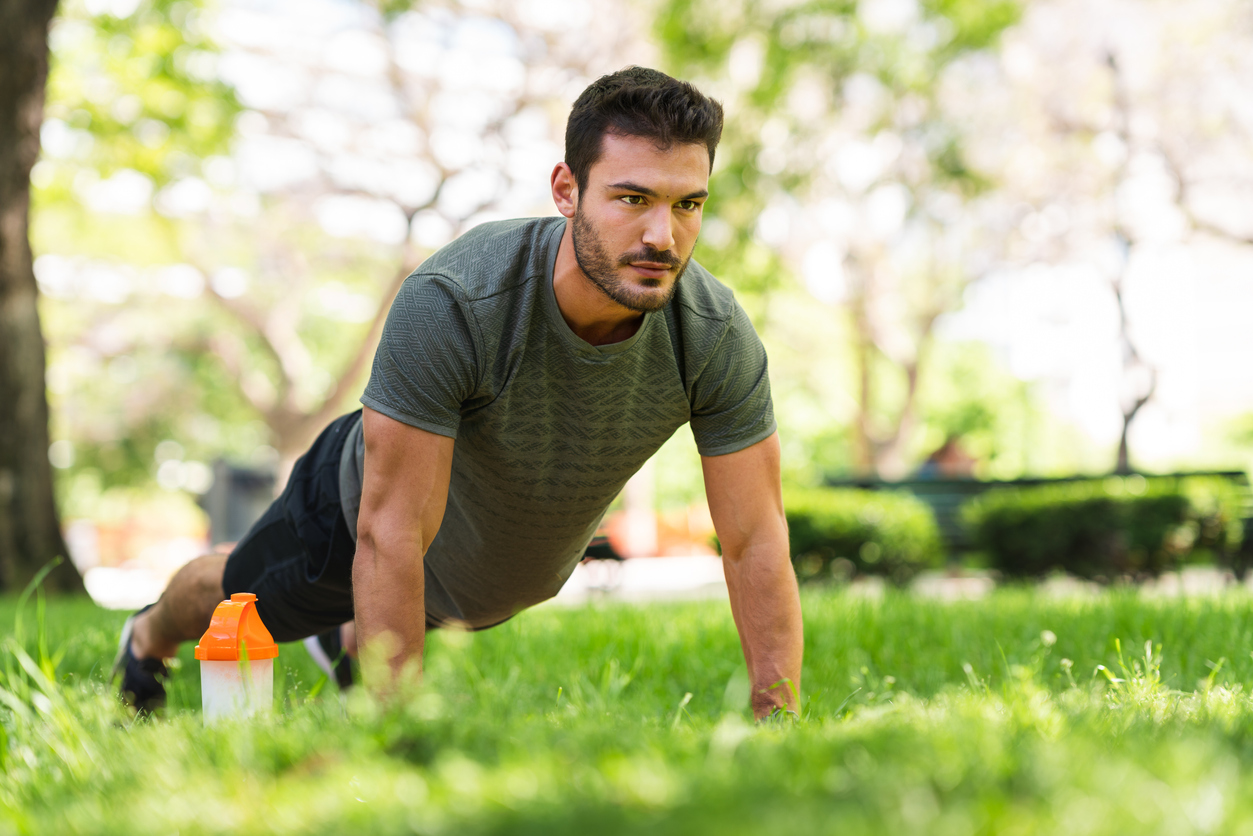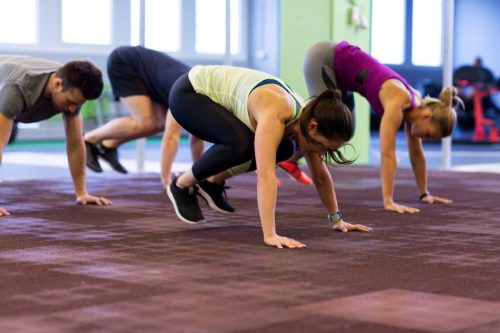9 Best Bodyweight Exercises You Can Do Anywhere, Fitness Experts Say

As any fitness expert will tell you, the best workout routine is the one you’ll actually stick to. That’s because even the most minor hurdles can get in the way of our best intentions to exercise. For instance, having a 15-minute commute to the gym or spending a couple of nights in a hotel could very well be the sticking point that stops you from breaking a sweat if you’re not completely committed. To make real progress, it helps to remove as many boundaries as possible between you and your routine—which is why we’ve set out to discover the best bodyweight exercises that require no equipment or forethought.
“These bodyweight exercises offer a convenient and effective way to stay active and maintain fitness, whether at home, in the gym, or while traveling,” says Elena “Elle” Brown, a seasoned yoga instructor and wellness coach at Get Well With Elle. “By incorporating these exercises into your routine, you can improve strength, flexibility, and overall physical fitness.”
Read on to learn the nine best bodyweight exercises you can do anywhere, as recommended by Brown and other fitness experts.
RELATED: 6 Best Walking Workouts for Weight Loss.
9 Best Bodyweight Exercises
1. Squats

Here’s the good news—your workout routine doesn’t need to be complicated in order for you to see results. In fact, starting with simple movements can help you build muscle tone and core strength as you build up your repertoire.
Brown recommends squats as a great building block for any lower-body workout. “Squats are a compound exercise that targets multiple muscle groups, including the quadriceps, hamstrings, glutes, and core. They improve lower body strength, stability, and mobility, making them essential for functional movement and everyday activities,” she tells Best Life.
If you’re looking for ways to shake up this classic move, there are also plenty of variations to choose from. You can get your heart rate pumping by adding an arm reach or arm circles, work different leg muscles by experimenting with various stance widths, hold the position for an isometric workout, and more.
2. Push-up matrix

Brown says she also recommends push-ups because they’re versatile and can be modified to suit different fitness levels.
“Push-ups are a classic upper body exercise that strengthens the chest, shoulders, triceps, and core. They also engage stabilizing muscles throughout the body, promoting better posture and alignment,” she says.
TJ Pierce, owner and head therapist at Pierce Family Wellness, suggests trying a push-up matrix for an added challenge. This takes a classic push-up and adds variations on hand position to work different muscle groups.
“The push-up matrix is highly beneficial because it works all three fiber orientations of the pectoralis major muscle while also working all three heads of the tricep muscles,” Pierce tells Best Life. “The full push-up matrix involves somewhere between 50 and 65 repetitions, so it ensures that you work all muscle fiber types.”
RELATED: 5 Best Resistance Workouts for Women Over 50, According to Experts.
3. Lunges

Lunges are another simple yet effective exercise you can do anywhere. Combining them in seamless motion with other basic moves like squats can ramp up the level of difficulty.
“Lunges are excellent for developing lower body strength, balance, and coordination. They target the quadriceps, hamstrings, glutes, and calves, while also engaging the core for stability,” says Brown. “Lunges can be performed in various directions to challenge different muscle groups and movement patterns.”
4. Short hinge oblique sit-ups

Next, Pierce recommends trying short hinge oblique sit-ups, which use a short range of targeted motion for maximal results.
To try them, lay on the ground with your feet planted and your knees bent, then bring your right ankle to rest on your left knee. With your left arm and your hand behind your head, do a sit-up in a diagonal motion, bringing your left elbow to your right knee. Then switch sides.
“The short hinge obliques work the rectus abdominus, internal oblique, external oblique, and transverse abdominus muscles all in one movement,” explains Pierce. “This is a great abdominal exercise as it not only builds muscle and endurance but provides a pumping of all the abdominal organs.”
For an added variation, try bicycle sit ups—oblique sit ups in which you extend one leg to hover above the ground while bringing the other knee to your elbow.
RELATED: Chair Yoga Is the New All-Ages Fitness Trend That Can Make You Look and Feel Younger.
5. Planks

Another powerful exercise that takes up little time or space is the plank.
“Planks are a core-strengthening exercise that also engage the shoulders, chest, and back muscles,” explains Brown. “They improve core stability, posture, and spinal alignment, helping to prevent lower back pain and injury. Planks can be modified to suit different fitness levels and can be held for varying durations to increase intensity.”
Harvard Health Publishing recommends starting small and adding repetitions. Aim to hold your plank for 10 to 30 seconds if you’re trying it for the first time, with the ultimate goal of planking for one to two minutes, they suggest.
6. Mountain climbers

If you’re already in the plank position, mountain climbers are your natural next move. With your shoulders stabilizing your upper body, you’ll bring your right knee up toward your chest toward your right elbow before returning to the plank position and switching sides. Regardless of your pace, it’s a good idea to try to find a consistent rhythm.
“Mountain climbers are a dynamic, full-body exercise that elevates the heart rate and improves cardiovascular fitness. They target the core, shoulders, chest, and legs while also enhancing coordination and agility,” says Brown. “Mountain climbers can be performed at a fast pace for a high-intensity cardio workout or at a slower pace for more controlled strength training.”
RELATED: The 7 Best Treadmill Exercises for Weight Loss, Fitness Experts Say.
7. Burpees

Burpees are another great way to engage your entire body with one exercise.
“Burpees work multiple muscle groups (legs, chest, arms) and elevate heart rate for cardiovascular benefits,” says Solveig Eitungjerde, the holistic health coach behind Live Well and Explore. She adds that the exercise “combines strength training and aerobic conditioning in one move.”
8. Wall sits with segmental leg positioning

For another variation of a squat you can try just about anywhere, try wall sits. Begin by standing up straight about two feet away from a wall, then lower your hips into a squat until your knees are at a 90-degree angle and your back is firmly against the wall.
To target even more muscle groups, Pierce recommends segmental leg positioning. To try this, you’ll do four positions in total: feet and knees together, feet together and knees apart, feet apart and knees together, and both feet and knees apart.
“The wall sit with segmental positioning of the legs works all four fiber orientations of the gluteus maximus muscle,” says Pierce. “This exercise works all of the leg muscles and, as an added bonus, is scientifically proven to lower blood pressure.”
RELATED: 4 Simple Exercises for a Flat Belly at Any Age.
9. Prone back extension with rotation

If you’re looking to strengthen your back and core while also improving posture and spinal alignment, Pierce recommends trying a prone back extension. To do this bodyweight exercise, lay down with your belly against the ground and your arms down at your sides. Then, lift your head and hands off the ground, holding your muscles in
To try it with rotation, bring your arms up and place the backs of your hands on your forehead. Lift your head, then twist your body and touch one elbow to the ground before re-centering your body, bringing your head down again. Switch back and forth between your right and left sides.
“By performing extension and rotation from a prone position, you work all of the spinal extensor muscles. Because these muscles are the first to be innovated by the spinal cord, exercising these muscles creates a relaxation effect in the central nervous system,” Pierce says.